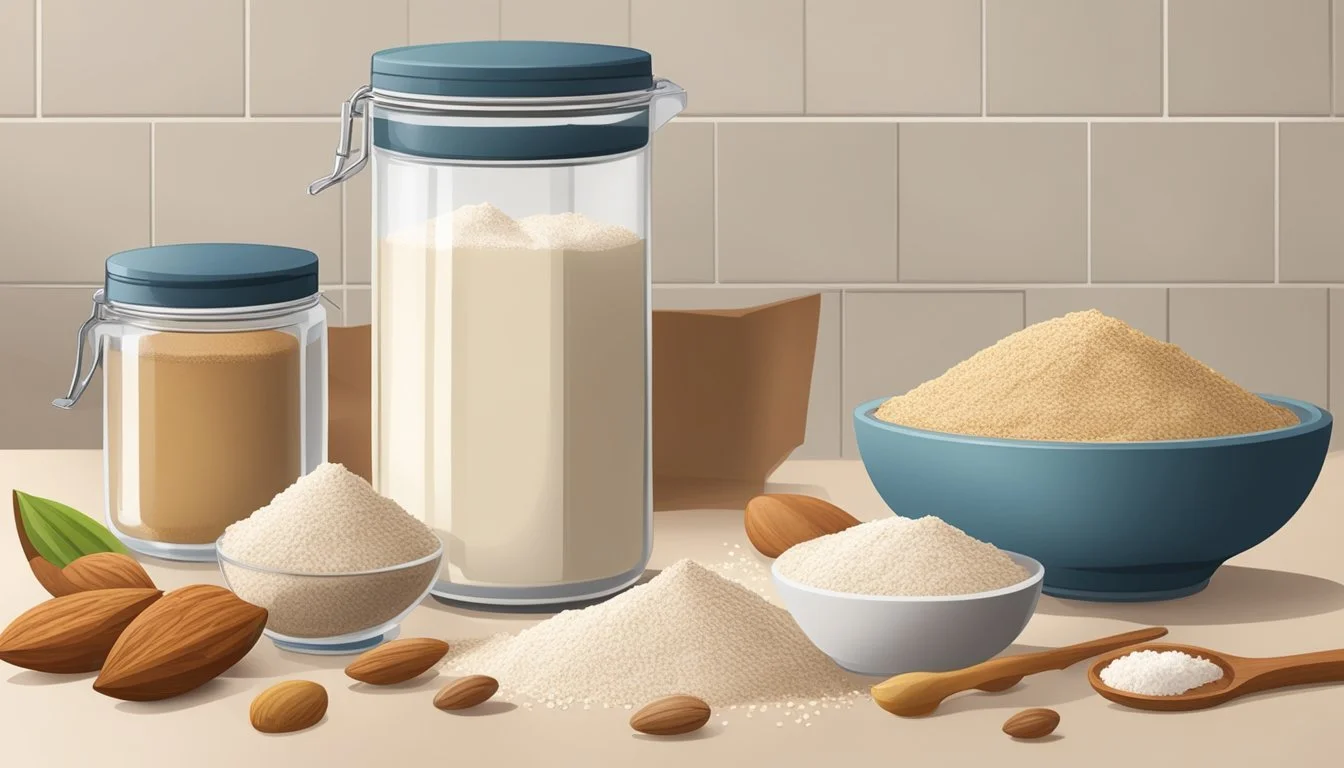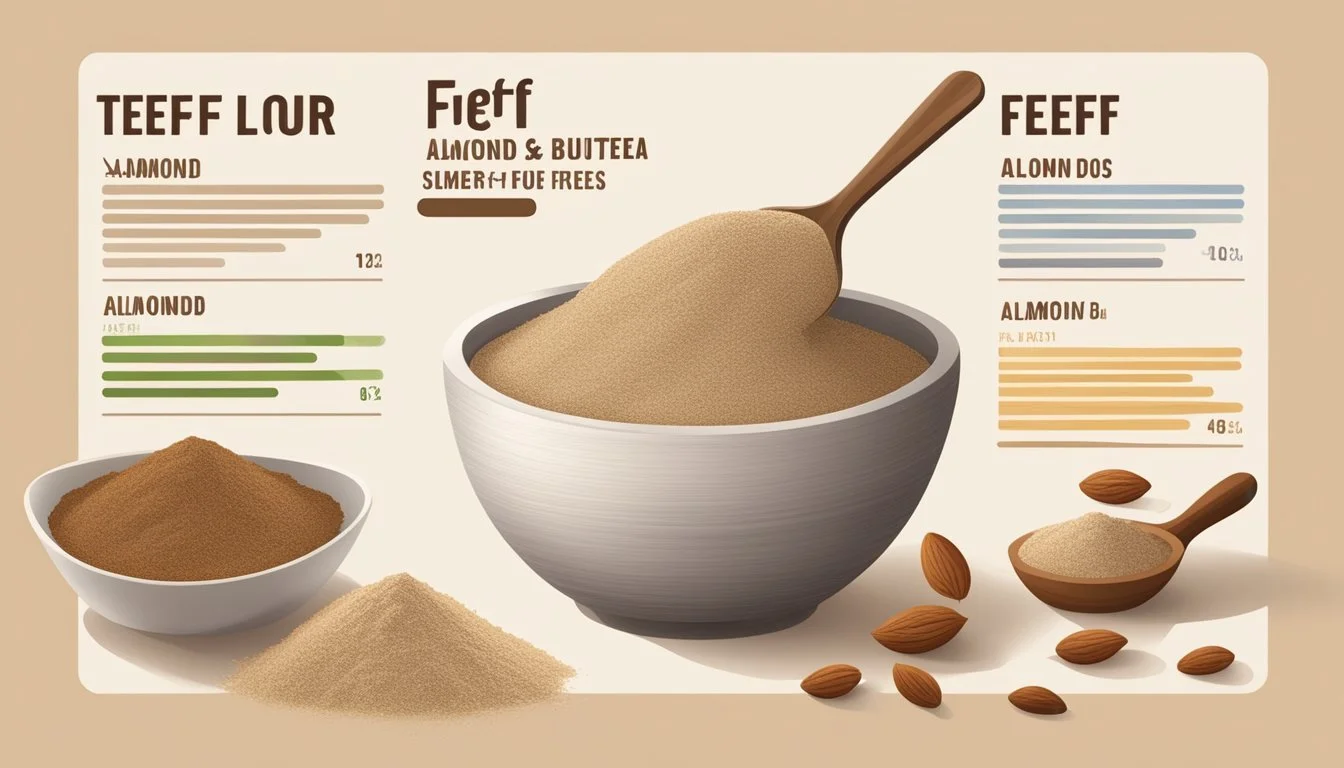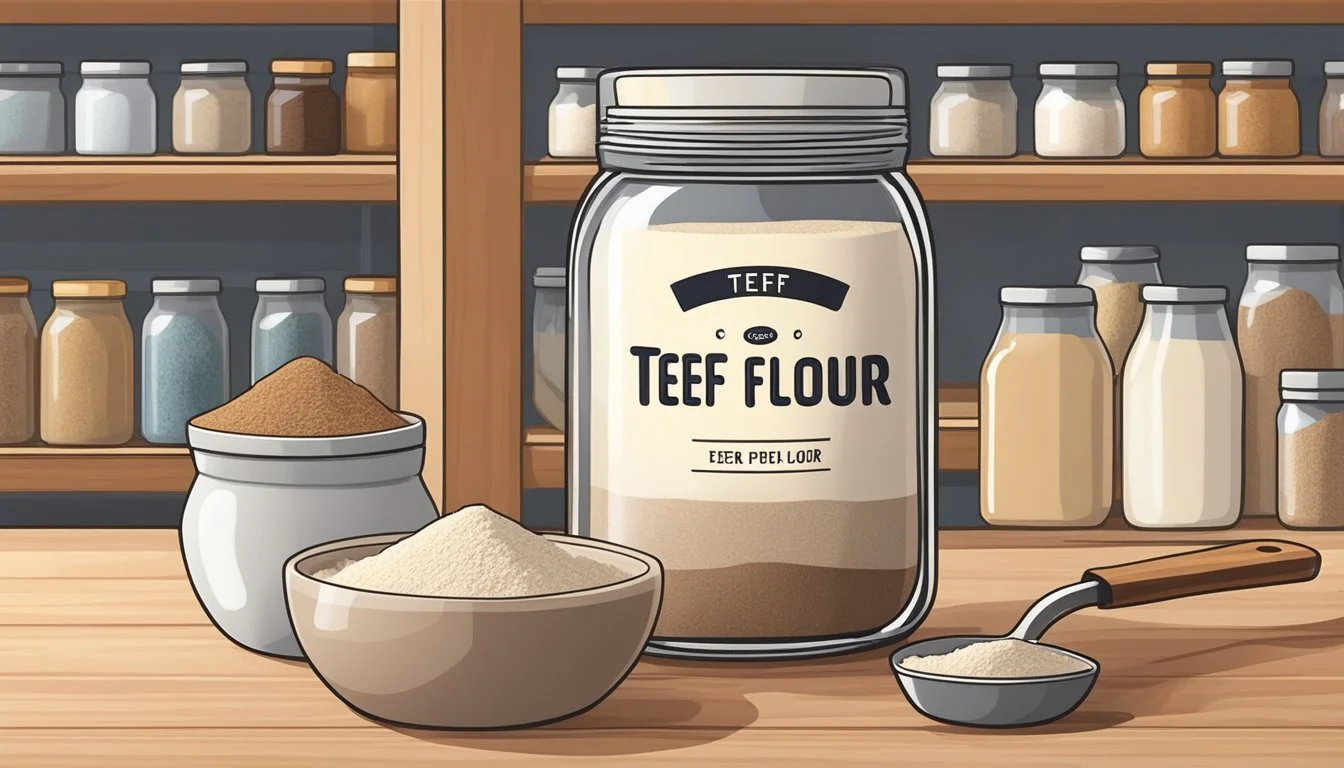Teff Flour Substitutes
Top Alternatives for Every Recipe
Teff flour, an ancient grain originating from Ethiopia, has gained popularity for its unique nutritional profile and gluten-free properties. For those looking to replace teff flour, there are several substitutes that cater to various dietary needs and culinary uses. Whether you're making bread, pancakes, or thick stews, finding the right alternative can make a significant difference in the texture and flavor of your dishes.
Among the top substitutes for teff flour are quinoa flour and buckwheat flour. Quinoa flour offers a nutty and earthy flavor, though it's advisable to use it sparingly to prevent bitterness. On the other hand, buckwheat flour can be used in a one-to-one ratio with teff flour, making it a convenient option for many recipes.
Other notable substitutes include almond flour and sorghum flour. Almond flour is a popular gluten-free option, providing a mild, nutty taste. Sorghum flour, known for its versatility in baking and cooking, can enhance the texture and richness of bread and pancakes. With these alternatives, culinary enthusiasts can experiment and find the perfect fit for their recipes, while enjoying the health benefits associated with these grains.
Nutritional Profile of Teff Flour
Teff flour is known for its impressive nutritional value, offering a range of vitamins, minerals, protein, and fiber. It's a nutrient-rich option that can enhance dietary intake in various ways.
Richness in Vitamins and Minerals
Teff flour is packed with essential vitamins and minerals. It contains significant amounts of iron, which is crucial for red blood cell production and preventing anemia. Additionally, teff is a good source of calcium and magnesium, essential for bone health and muscle function.
Phosphorus, found in teff flour, supports healthy bones and teeth. The flour also includes B vitamins such as thiamin, riboflavin, and niacin, which aid in energy metabolism and maintain healthy skin and nerves. These nutrients make teff flour a valuable addition to any diet.
High Protein and Fiber Content
Teff flour stands out for its high protein and fiber content. It contains all eight essential amino acids, making it a complete protein source. This is particularly beneficial for those on plant-based diets. The protein content supports muscle repair and growth.
The fiber in teff flour aids in digestion and helps maintain stable blood sugar levels. It also contributes to satiety, making it a good choice for weight management. The combination of protein and fiber enhances overall nutrition and supports various physiological functions.
Gluten-Free Baking with Teff Flour
Teff flour offers unique properties for gluten-free baking, making it a suitable choice for various baked goods. Learn how to adjust ratios in recipes to achieve the perfect consistency and texture for your gluten-free treats.
Unique Properties for Baking
Teff flour stands out for its nutty flavor and slightly earthy taste, enriching the flavor of gluten-free baked goods like bread, cookies, and cakes. It is rich in nutrients such as calcium, and iron and provides high fiber content. This makes it a healthier option compared to many other gluten-free flours.
Its fine texture lends well to making smooth batters and doughs, ideal for pancakes, waffles, and injera. The natural binding properties of teff flour contribute to better consistency, which is often a challenge in gluten-free baking.
Adjusting Ratios in Recipes
When substituting teff flour for regular flour in a recipe, adjustments are necessary due to its unique texture and moisture absorption. Typically, teff flour can replace up to 25-50% of wheat flour in recipes. For entirely gluten-free dishes, combine teff flour with other gluten-free flours like rice flour, sorghum flour, or quinoa flour.
For baked goods such as muffins, cookies, and bread, adding a bit of xanthan gum or guar gum can aid in binding and improving texture.
In pancakes and waffles, using eggs or egg substitutes can help achieve the desired fluffiness.
닌 Using these adjustments helps attain a texture that remains moist without being too dense, ensuring your gluten-free baking success.
Popular Teff Flour Substitutes
Teff flour is known for its nutty flavor and unique texture, making it a popular choice in gluten-free baking. Below, we will explore various substitutes for teff flour, including grain-based and nut and root-based options.
Grain-Based Flours
Quinoa Flour
Quinoa flour provides a nutty and earthy flavor similar to teff. It contributes a dense texture, ideal for making bread and baked goods. Quinoa flour can sometimes be slightly bitter, so it is best used in moderation. Mixing it with other gluten-free flours can balance the flavor and consistency of your recipes.
Oat Flour
Oat flour is a versatile teff flour substitute with a mild flavor. It aligns well with the texture of teff and is suitable for a variety of baked goods. When substituting oat flour for teff flour, consider adding a binder like xanthan gum or psyllium husk powder to replicate the binding property of teff.
Buckwheat Flour
Buckwheat flour is another gluten-free option that can replace teff flour. It offers a rich, earthy taste and a robust texture, making it suitable for hearty breads and pancakes. Its consistency allows for a direct 1:1 substitution with teff flour, maintaining the integrity of your recipes.
Nut and Root-Based Flours
Almond Flour
Almond flour is a popular nut-based substitute for teff flour, bringing a slightly sweet and creamy flavor. It works best in baked goods like cakes, cookies, and muffins. Almond flour absorbs more moisture, so you might need to adjust the liquid content of your recipe to achieve the desired consistency.
Coconut Flour
Coconut flour can serve as a substitute for teff flour, offering a subtly sweet flavor. It’s highly absorbent, meaning you will need to use significantly less coconut flour—approximately ¼ cup for every cup of teff flour. Adjusting the liquid content in your recipe is crucial to prevent dryness.
Cassava Flour
Derived from the cassava root, cassava flour is a versatile substitute for teff flour. It has a mild, neutral flavor that won't overpower your dishes. Cassava flour closely mimics the texture and consistency of teff, making it suitable for various gluten-free recipes. Use it in equal proportions as you would teff flour.
Specific Substitutions for Teff Flour
Teff flour has a unique consistency and nutritional profile that can be matched by several substitutes, depending on the type of dish. For sweet baked goods, bread and flatbreads, and thickening sauces and gravies, different flours can provide the desired results.
Best for Sweet Baked Goods
For sweet baked goods, quinoa flour and coconut flour are excellent choices. Quinoa flour offers a nutty and earthy flavor that complements many desserts. It’s important to note that a little goes a long way, as too much can introduce a bitter taste.
Coconut flour is another substitute that works well for sweet treats. It absorbs more liquid than teff flour, so recipes may require additional moisture. Use ¼ cup of coconut flour for every 1 cup of teff flour and adjust liquid content accordingly. This ensures the baked goods remain moist and flavorful.
Best for Bread and Flatbreads
In bread and flatbread recipes, wheat flour and buckwheat flour can replace teff flour effectively. Wheat flour, including all-purpose and whole wheat, offers a similar consistency for non-gluten-free recipes. It provides good structure and a similar texture.
If a gluten-free option is needed, buckwheat flour can be used. It shares a similar nutty flavor with teff flour and works well in bread recipes. Use the same amount of buckwheat flour as teff flour for the best results. Another option is rice flour, which is also gluten-free and suitable for various types of bread.
Best for Thickening Sauces and Gravies
When thickening sauces and gravies, tapioca flour and cornstarch are suitable substitutes for teff flour. Tapioca flour, derived from cassava root, provides a smooth texture and is particularly effective in gluten-free cooking. Use it in equal parts to teff flour.
Cornstarch is another reliable thickening agent. It is neutral in flavor and works well in both sweet and savory sauces. Typically, use half the amount of cornstarch compared to teff flour to achieve the desired consistency. Corn flour can also be a viable option, especially for thicker sauces that require a more substantial consistency.
Considerations for Dietary Restrictions
When looking for substitutes for teff flour, it's important to consider dietary restrictions such as gluten intolerance and diabetes. Different alternatives offer unique benefits while accommodating specific health needs.
Alternatives for Celiac and Gluten Intolerance
Teff flour is naturally gluten-free, making it a good choice for those with celiac disease or gluten intolerance. However, when teff flour is unavailable, several alternatives can be used:
Coconut Flour: This is a popular choice, but it absorbs a lot of liquid, so recipes may need extra moisture.
Buckwheat Flour: Despite its name, it is gluten-free and offers a similar nuttiness to teff. It can be used in the same quantity as teff flour in recipes.
Amaranth Flour: This lesser-known flour provides a nutty flavor and is also gluten-free. It works well in various baked goods.
By choosing the right gluten-free substitute, individuals can enjoy a wide range of dishes without compromising their dietary needs.
Low Glycemic Options for Diabetes
Diabetes management requires careful attention to the glycemic index (GI) of foods. Choosing low GI flours helps maintain blood sugar levels.
Coconut Flour: With a low glycemic index, it’s suitable for diabetes-friendly recipes. Additionally, its high fiber content helps stabilize blood sugar.
Almond Flour: Also low GI and high in healthy fats and fiber, almond flour is excellent for low-carb, diabetes-friendly baking.
Chickpea Flour: This alternative has a moderate GI but is rich in protein and fiber, making it a suitable choice for those managing diabetes.
In summary, selecting substitutes like coconut, almond, or chickpea flour can help create diabetes-friendly recipes while maintaining the nutritional benefits of low GI foods.
Cultural and Culinary Applications
Teff flour's distinctive mild, nutty flavor and versatility make it a standout ingredient in various global cuisines. Here, we explore how this unique grain is utilized in traditional Ethiopian dishes, Latin American recipes, and modern culinary innovations around the world.
Traditional Ethiopian Cuisine
Teff, a staple in Ethiopian cuisine, is primarily used to make injera, a sourdough flatbread central to many meals. Injera is prepared by fermenting teff flour and combining it with water, resulting in a spongy, slightly tangy bread. It serves as both a plate and utensil, with various stews and dishes like Doro Wat (spicy chicken stew) placed on top.
The tiny grains of teff also contribute to other traditional dishes. Porridge made from teff flour is a common breakfast in Ethiopia, providing a nutritious start to the day. The incorporation of teff into daily meals highlights its significance as an Ethiopian grain, valued for its flavor and nutritional benefits.
Latin American Dishes
Though teff is not native to Latin America, it has found its way into various dishes due to its versatility. In countries like Peru and Bolivia, teff flour is used in gluten-free baking. Its unique, nutty flavor complements sweet and savory baked goods such as empanadas and tortillas.
Additionally, teff is sometimes combined with traditional Latin American grains like amaranth and quinoa. This combination enriches the nutrient profile of the dish and introduces a new dimension of flavor. The adaptability of teff allows it to fit seamlessly into these cultural recipes while enhancing their taste and nutritional value.
Global Inspirations in Modern Cooking
Teff's mild flavor and nutritional content make it an attractive ingredient for contemporary chefs worldwide. In India, teff flour is being used as a substitute in traditional recipes like dosas and rotis, catering to those with gluten sensitivities.
In Western countries, teff is increasingly popular in health-conscious and gluten-free baking. It's used in recipes for pancakes, muffins, and bread. Its ability to blend with other gluten-free flours, like almond or coconut flour, makes it a versatile choice for a variety of baked goods.
Overall, teff’s adaptability allows it to be integrated into many culinary applications. From traditional to modern dishes, this ancient grain continues to gain appreciation and utilization in various cultures and cuisines across the globe.
Creating Homemade Flour Blends
Creating homemade flour blends allows home bakers to customize their recipes for enhanced nutrition, distinct textures, and unique flavors. By mixing different flours, one can achieve specific culinary goals while incorporating diverse nutrients from whole grains.
Combining Flours for Enhanced Nutrition
By combining various flours, a more nutritious blend can be created. Mixing quinoa flour with sorghum flour, for instance, adds a good amount of protein and essential amino acids.
Similarly, oat flour and millet flour can be combined to boost fiber content and include B vitamins.
Soy flour is another excellent option to increase protein and provide iron and calcium. This method is particularly useful for creating healthier baking options such as whole grain breads and muffins. Using a blend also helps leverage the unique benefits of each grain, as some are rich in minerals while others are high in vitamins.
Custom Mixes for Texture and Flavor
Choosing the right flours for a homemade blend can significantly alter the texture and flavor of the final product. For a tender texture in cookies, combining rice flour with coconut flour can provide a light and airy crumb.
Buckwheat flour adds a robust flavor and denser texture suitable for pancakes or hearty breads.
For a mild and neutral flavor, tapioca flour can be mixed with other gluten-free flours to avoid overpowering the taste of the finished baked goods. By experimenting with different combinations, bakers can create unique textures and flavors that cater to their specific preferences and dietary needs.
Tips for Storing and Using Flour Substitutes
Storing and using flour substitutes effectively can help maintain their quality and ensure consistent results in your recipes. Attention to storage conditions and moisture adjustments are key points for optimal performance.
Proper Storage for Longevity
Proper storage is essential for extending the shelf life of flour substitutes. Most flour substitutes, such as coconut or quinoa flour, should be kept in an airtight container to prevent moisture absorption and maintain texture.
Flours should be stored in a cool, dark place, ideally in the pantry or refrigerator. Refrigeration can help retain the mild, nutty flavor of substitutes like buckwheat or almond flour. Freezing flour substitutes is another good option, particularly for long-term storage, but they must be sealed well to prevent freezer burn.
Adjusting Moisture in Recipes
Adjusting moisture levels is necessary when using substitutes like coconut or almond flour, which absorb more liquid than traditional flours. For example, coconut flour often requires an increase in liquid ingredients to achieve the desired consistency.
Tapioca flour and arrowroot powder can help bind and provide a smoother texture, especially in gluten-free recipes. Monitoring and adjusting accordingly will ensure your baked goods maintain the right consistency and provide the best results. Buckwheat flour can be used in a 1:1 ratio to teff flour but may need slight liquid adjustments depending on the recipe.






